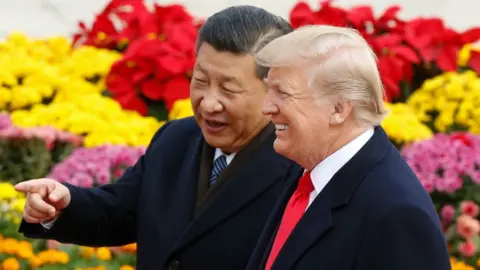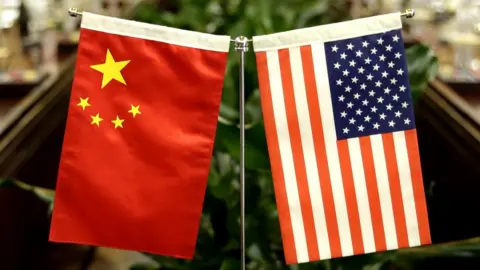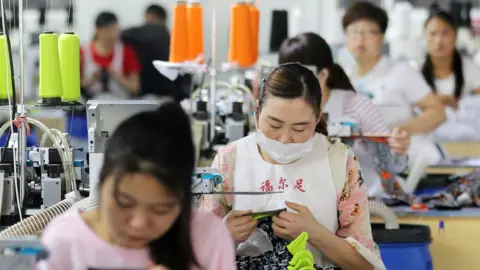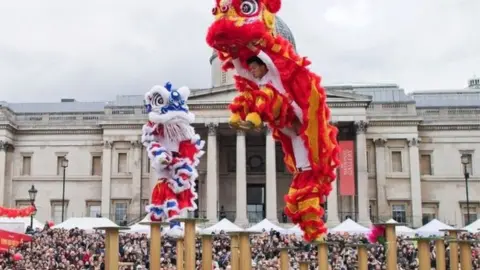Trade war truce: A win for the US or China?
 Getty Images
Getty ImagesAfter months of threats and tit-for-tat tariffs, finally a Christmas gift in the form of no new tariffs on 1 January from both the US and China.
The rapprochement between the two sides will no doubt bring some respite to markets and investors.
Expect share markets in Asia to pop up on Monday, as the concern of investors that a protracted trade war would begin at the dawn of 2019 will begin to fade, for now.
You shouldn't be surprised by that. The trade war between the world's two largest economies has been a major risk factor for investors this year, as it has threatened economic forecasts for countries across the Asia Pacific region.
And despite some gloomy predictions - mine included - for the world's most watched dinner date, the personal chemistry of President Trump and President Xi appeared to be the cementing force to get the US and China to agree to what seemed like two diametrically opposing viewpoints.
But as always - the devil is in the detail - and truth be told, there's not much detail when it comes to this deal.
So let's unpick their agreement.
A deal for domestic audiences
This was a deal that both sides needed to play well at home. Which is why it was interesting that the first inkling we had of an agreement actually came from Chinese media.
Both China Daily and Chinese international broadcaster CGTN said that President Trump and President Xi had agreed not to impose new tariffs after 1 January.
President Xi has been grappling with a slowing economy at home, and analysts say he's been under pressure to come home with some sort of a deal that wouldn't exert more pain on Chinese manufacturers.
 AFP
AFPThere's some evidence that companies in China are seeing some pain because of the trade war, but for now, at the 10% level, it's been manageable. A 25% increase would change things dramatically.
Ditto for President Trump. US lobby groups have pressed him to put aside differences with China and pointed out that higher tariffs would mean higher costs for American manufacturers - which would in turn lead to higher prices for US consumers.
He's publicly brushed aside those concerns before, but this deal will help him look strong back home, whilst also granting US companies more time to figure out what to do if the next set of tariffs do come into effect.
What does the US get?
The US, at first glance, does come out better in this deal.
President Trump has managed to get China to agree to talk about some key problems his administration has with the way Beijing does business - and an agreement to get China to buy a "very substantial" amount of agricultural, energy and industrial goods from the US.
There's also the Qualcomm and NXP Semiconductors deal - an unwitting victim of the trade war - that President Xi said he "is open to" approving, after Beijing failed to approve the merger earlier this year.
 Getty Images
Getty ImagesAnalysts say we could see a possible approval on that front if the talks over the next 12 weeks go well.
President Trump also praised China on North Korea - a key part of his relationship with President Xi, and that the two will work towards a nuclear free Korean peninsula.
But China has also ensured that the language of this agreement is vague, and non binding - which means it is not clear at all how much Beijing has to open up, or how much it will buy from the US.
It is all in the timing
This is a key part of the agreement. China and the US have agreed to immediately begin negotiations on structural changes with respect to forced technology transfer, intellectual property protection, non-tariff barriers, cyber intrusions and cyber theft, services and agriculture - within the next 90 days.
If they cannot reach an agreement, the 10% tariffs will be raised up to 25%. This deadline takes us past the Chinese New Year holiday, and basically buys both sides more time.
The US wants China to give up forced technology transfers and give American firms more access to the Chinese market.
 AFP
AFPWhether China has the same definition of what that means, will be the key gauge of whether their talks are successful. But things are changing in Beijing, at least according to an editorial in the Global Times, often seen as a mouthpiece for the Chinese Communist Party.
In today's edition, commenting on the Xi-Trump truce, it says "Any decision that benefits China's development is right."
Perhaps from a position of self-interest, this temporary reprieve is worth sacrificing for.
How much China will sacrifice though, will be key to whether this deal is anything more than just a temporary truce, or a long-lasting definitive re-writing of the US-China relationship.
Interestingly the 90 day timeline doesn't appear to get much of a mention in Chinese media - which may be trying to spin this as a complete victory for President Xi, rather than what it is: a temporary truce for the Christmas holidays.
No more tit-for-tat tweets, or tariff threats - for now at least. But without real specifics, and some serious giving in from China, it is hard to see that we won't be back at this position in three months' time.
And next time - it will be for real - and not just on trade.
There are already rumblings in the Trump White House of restricting visas to Chinese academics and students. This reprieve may be a welcome respite from the antagonism of recent months - but if the two sides don't come to a credible and substantive deal - things could be much worse in the future.
